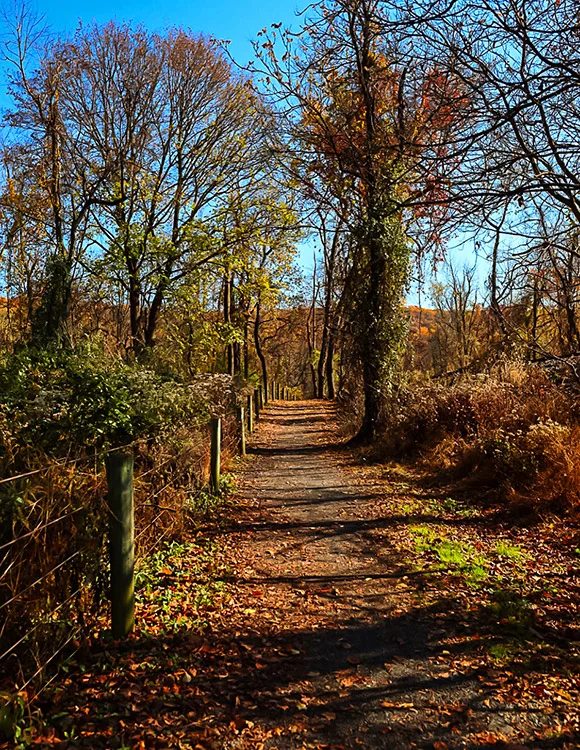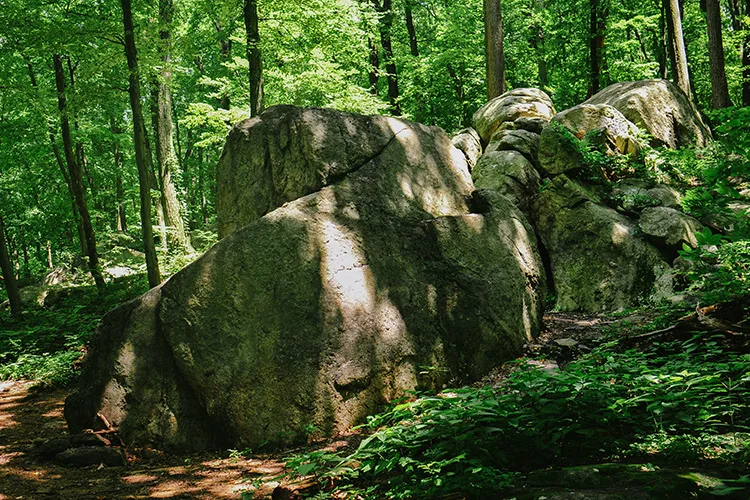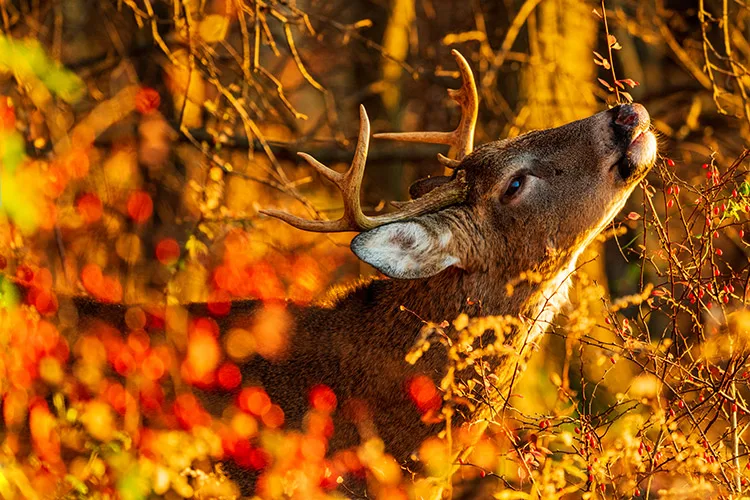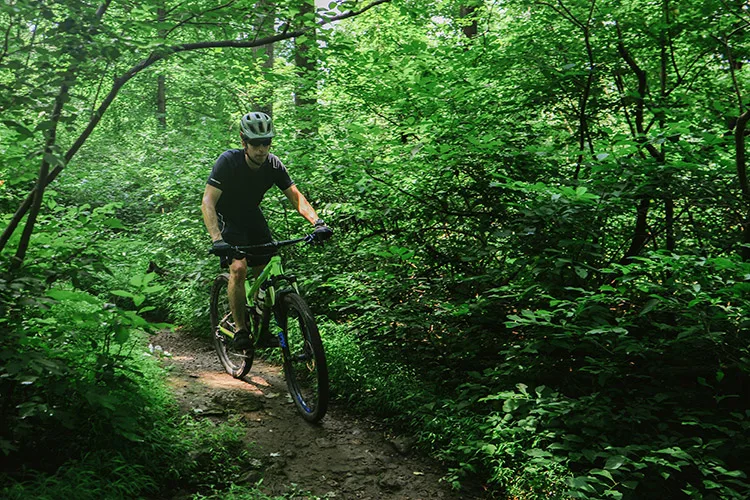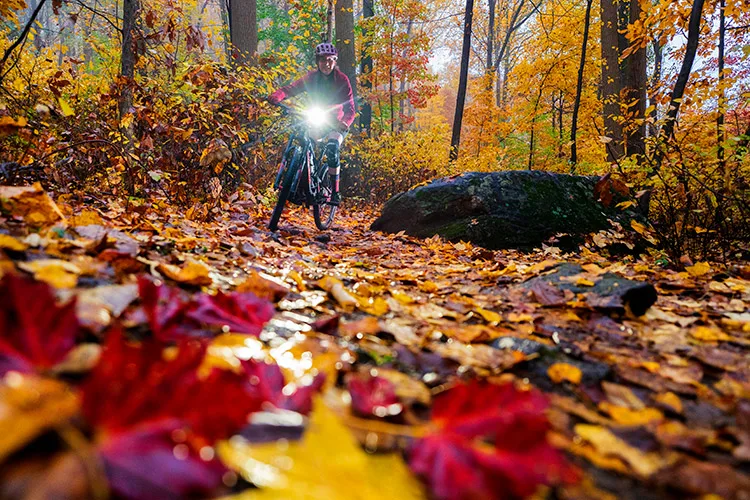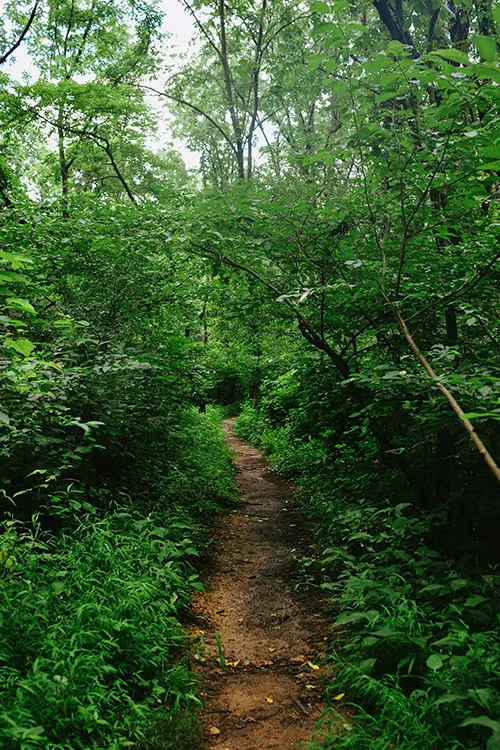This was Wildlands Conservancy’s first nature preserve and was permanently protected in 1973. This 440-acre preserve boasts nearly 12 miles of woodland trails and is a beloved hiking and biking oasis. It is a heavily forested preserve with rocky outcrops and overlooks of the Lehigh Valley.
ADA loop | 0.2 miles | Easy
This trail is a 0.2 mile loop around our habitat regeneration deer exclosure area. It can be accessed by taking the middle trail at the Boroline Park trailhead and keeping on the crushed stone path. Total elevation changes of only 10 ft. along this route.
Alpine St Trail | 1.7 miles | Difficult
This loop is a climb necessary to reach the upper trails. The trail is rocky in many places and crosses several small streams. Spectacular boulder formations and reclaimed quarry areas are major features on this route. Please be mindful and avoid the marked trails leading to private property at the edges of the preserve. Elevation changes 230 feet.
Alpine/Ithaca On-street Connection | 1.7 miles | Easy
This on-street connection runs on Glenwood St. between Ithaca Playlot and Boroline Park. Trail markers on utility poles and the backs of stop signs mark the route. This trail is smoothly paved but does not include sidewalks, and climbs 50 ft from Ithaca Playlot to Boroline Park.
Bloodroot Trail | 1.6 miles | Difficult
At the far reaches of South Mountain Preserve, hikers and bikers wind through the forest to discover solitude that’s seldom found in the greater nearby landscape. Built by Valley Mountain Bikers who switched gears to volunteer, this trail displays our community’s dedicated time (120+ hours) and talent.
Bug Trail | 0.9 miles | Difficult
This trail is named in memorial- not for a prevalence of insects. The trail is very rugged and can be difficult in places. There are many switchbacks and elevation changes along this trail, which connects the Trout Run and Uplands trails. A large glacial boulder stands about the forest floor on the south side of the trail. Elevation change of 130 ft.
Double R Trail | 0.9 miles | Difficult
The Double R trail offers some of the most challenging hiking and biking on the Preserve. Users must venture far from the parking lots to access this trail, which consists of rocky switchbacks, steep climbs, and a secondary loop.
Kline’s Lane Trail | 0.8 miles | Easy
Klines Lane Trail is an ADA accessible trail that connects Wildlands Conservancy’s South Mountain Preserve to Emmaus’ Klines Lane Open Space.
Log Trail | 1.8 miles | Easy
This winding trail was constructed with mountain bikers in mind but is open to hikers also. To access the trail, users must traverse the utility corridor from the Upland trail–watching for trail markers designating the beginning of the Log Trail. Extensive communities of spring flowers like Mayapple are found on this mountaintop trail. This is an easy trail with elevation changes of 110ft.
Mountain Top Trail | .8 miles | Moderate
This multi-use trail offers many elevation changes and switchback turns and is a favorite of mountain bikers. Elevations change 160 feet.
Trout Run Trail | 1.2 miles | Moderate
This trail offers a spectacular overlook of Emmaus and Allentown through a utility cut. The trail also crosses babbling streams running down the hillside and has great views of unique boulder formations. It can be rocky and uneven in areas with elevation changes of 220 feet.
Uplands Trail | 1.1 miles | Difficult
This trail providing access to the Mountain Top and Log trails is relatively easy to walk, but is rocky and uneven in areas. Elevation changes 270 along this trail.
Wilderness Trail | .6 miles | Easy
The Wilderness trail connects the Alpine Street trail to Ithaca Playlot and the Alpine/Ithaca On street trail completes a loop back to the Alpine trail; creating an enjoyable hiking with a large variety of trail types. This trail passes old mining sites, from South Mountain’s Industrial Revolution past, which have since been reclaimed by nature to create pools that are vital for amphibian populations. This easy trail only climbs 90 ft from Ithaca Playlot to the Alpine St. trail.
South Mountain provides habitat for endangered bat species and many bird species including Baltimore oriels, pileated woodpeckers, veery, black-throated blue warblers, worm-eating warblers, and ovenbirds. Its bogs and streams host rare insects and amphibians. Nature preserve users share trails with deer and foxes.
The largely deciduous forest contains a blend of red oak, tulip, maple, and beech, with some stands of over 100 years.
In early spring, even before the snows melt, one of the earliest spring wildflowers blooms on South Mountain – skunk cabbage. Skunk Cabbage blossoms appear weeks before the plant’s leaves, which will last through late fall, arrive. These blooms, which look like dappled brown or green hoods, melt through the snow by generating their own heat.
Other notable plant species include spicebush, wineberry bushes, and eastern redbud trees.
A handful of forward-thinking citizens put pencil to paper to permanently protect their beloved South Mountain and the natural beauty it cast upon the Lehigh Valley. Their efforts were matched with the committed support of Robert “Bob” Rodale, a local champion of organic farming and then chairman and chief of Rodale Press. Rodale’s move enabled the purchase of South Mountain Preserve as one of the organization’s first land acquisitions in 1973.
Before its protection, the mountain served the Lenni Lenape people by providing settlements, refuge, and a vital source of trade materials. European settlements were founded by the Moravians, who settled in areas with vital drinking water sources, which flowed reliably, even in dry periods. As the green background in the Industrial Revolution, the forests were timbered for lumber and mined for iron ore, limestone for the steel mills, and, in limited quantities, gold and uranium.
– Preserve is open from dawn to dusk
– No motor vehicles or horses
– Be respectful of neighbors and private property
– Do not damage, disturb, or harm any plants, wildlife, or geology
– No graffiti
– No collecting of these natural resources
– Do not dump or litter; carry out all trash
– Pets must be leashed, under control at all times, and cleaned up after
– Be respectful of others using the property; quiet increases the chances of viewing wildlife
– No glass containers
– No camping or fires
– No alcohol, illegal drugs, or weapons
– Stay on trails
– No hunting or trapping
Want the latest news about our nature preserves?





